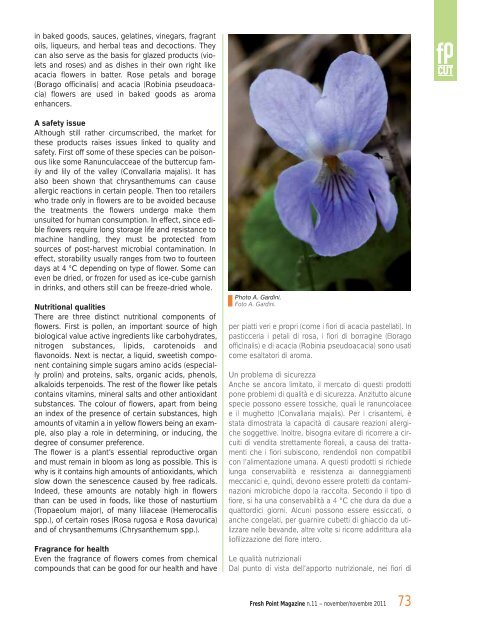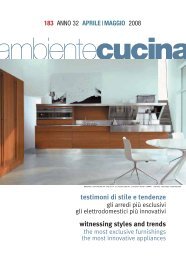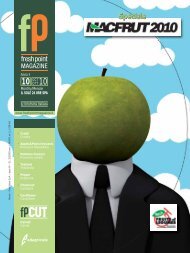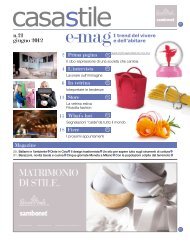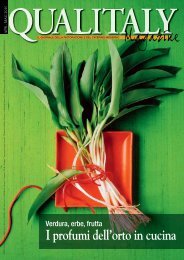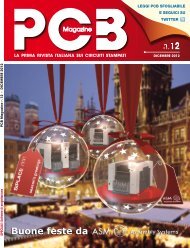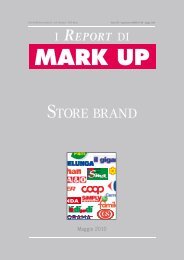Fresh Point Magazine - B2B24 - Il Sole 24 Ore
Fresh Point Magazine - B2B24 - Il Sole 24 Ore
Fresh Point Magazine - B2B24 - Il Sole 24 Ore
Create successful ePaper yourself
Turn your PDF publications into a flip-book with our unique Google optimized e-Paper software.
in baked goods, sauces, gelatines, vinegars, fragrant<br />
oils, liqueurs, and herbal teas and decoctions. They<br />
can also serve as the basis for glazed products (violets<br />
and roses) and as dishes in their own right like<br />
acacia flowers in batter. Rose petals and borage<br />
(Borago officinalis) and acacia (Robinia pseudoacacia)<br />
flowers are used in baked goods as aroma<br />
enhancers.<br />
A safety issue<br />
Although still rather circumscribed, the market for<br />
these products raises issues linked to quality and<br />
safety. First off some of these species can be poisonous<br />
like some Ranunculacceae of the buttercup family<br />
and lily of the valley (Convallaria majalis). It has<br />
also been shown that chrysanthemums can cause<br />
allergic reactions in certain people. Then too retailers<br />
who trade only in flowers are to be avoided because<br />
the treatments the flowers undergo make them<br />
unsuited for human consumption. In effect, since edible<br />
flowers require long storage life and resistance to<br />
machine handling, they must be protected from<br />
sources of post-harvest microbial contamination. In<br />
effect, storability usually ranges from two to fourteen<br />
days at 4 °C depending on type of flower. Some can<br />
even be dried, or frozen for used as ice-cube garnish<br />
in drinks, and others still can be freeze-dried whole.<br />
Nutritional qualities<br />
There are three distinct nutritional components of<br />
flowers. First is pollen, an important source of high<br />
biological value active ingredients like carbohydrates,<br />
nitrogen substances, lipids, carotenoids and<br />
flavonoids. Next is nectar, a liquid, sweetish component<br />
containing simple sugars amino acids (especially<br />
prolin) and proteins, salts, organic acids, phenols,<br />
alkaloids terpenoids. The rest of the flower like petals<br />
contains vitamins, mineral salts and other antioxidant<br />
substances. The colour of flowers, apart from being<br />
an index of the presence of certain substances, high<br />
amounts of vitamin a in yellow flowers being an example,<br />
also play a role in determining, or inducing, the<br />
degree of consumer preference.<br />
The flower is a plant’s essential reproductive organ<br />
and must remain in bloom as long as possible. This is<br />
why is it contains high amounts of antioxidants, which<br />
slow down the senescence caused by free radicals.<br />
Indeed, these amounts are notably high in flowers<br />
than can be used in foods, like those of nasturtium<br />
(Tropaeolum major), of many liliaceae (Hemerocallis<br />
spp.), of certain roses (Rosa rugosa e Rosa davurica)<br />
and of chrysanthemums (Chrysanthemum spp.).<br />
Fragrance for health<br />
Even the fragrance of flowers comes from chemical<br />
compounds that can be good for our health and have<br />
Photo A. Gardini.<br />
Foto A. Gardini.<br />
per piatti veri e propri (come i fiori di acacia pastellati). In<br />
pasticceria i petali di rosa, i fiori di borragine (Borago<br />
officinalis) e di acacia (Robinia pseudoacacia) sono usati<br />
come esaltatori di aroma.<br />
Un problema di sicurezza<br />
Anche se ancora limitato, il mercato di questi prodotti<br />
pone problemi di qualità e di sicurezza. Anzitutto alcune<br />
specie possono essere tossiche, quali le ranuncolacee<br />
e il mughetto (Convallaria majalis). Per i crisantemi, è<br />
stata dimostrata la capacità di causare reazioni allergiche<br />
soggettive. Inoltre, bisogna evitare di ricorrere a circuiti<br />
di vendita strettamente floreali, a causa dei trattamenti<br />
che i fiori subiscono, rendendoli non compatibili<br />
con l’alimentazione umana. A questi prodotti si richiede<br />
lunga conservabilità e resistenza ai danneggiamenti<br />
meccanici e, quindi, devono essere protetti da contaminazioni<br />
microbiche dopo la raccolta. Secondo il tipo di<br />
fiore, si ha una conservabilità a 4 °C che dura da due a<br />
quattordici giorni. Alcuni possono essere essiccati, o<br />
anche congelati, per guarnire cubetti di ghiaccio da utilizzare<br />
nelle bevande, altre volte si ricorre addirittura alla<br />
liofilizzazione del fiore intero.<br />
Le qualità nutrizionali<br />
Dal punto di vista dell’apporto nutrizionale, nei fiori di<br />
<strong>Fresh</strong> <strong>Point</strong> <strong>Magazine</strong> n.11 – november/novembre 2011<br />
73


